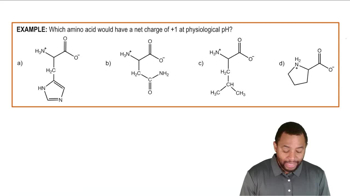Draw the structure for each of the following amino acids and put an asterisk (*) next to any chiral carbon centers in your structure:
b. lysine
 Verified step by step guidance
Verified step by step guidance Verified video answer for a similar problem:
Verified video answer for a similar problem:



 5:16m
5:16mMaster Nonpolar Amino Acids Concept 1 with a bite sized video explanation from Jules
Start learning